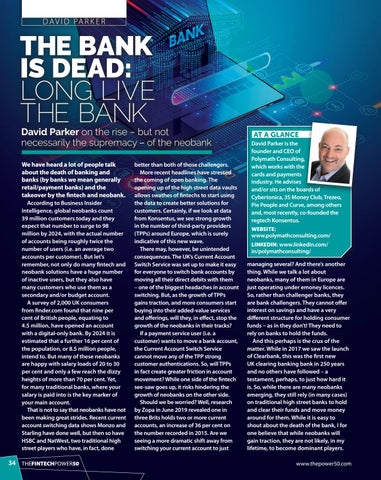D A V I D PA R K E R
THE BANK IS DEAD: LONG LIVE THE BANK
David Parker on the rise – but not necessarily the supremacy – of the neobank We have heard a lot of people talk about the death of banking and banks (by banks we mean generally retail/payment banks) and the takeover by the fintech and neobank. According to Business Insider Intelligence, global neobanks count 39 million customers today and they expect that number to surge to 98 million by 2024, with the actual number of accounts being roughly twice the number of users (i.e. an average two accounts per customer). But let’s remember, not only do many fintech and neobank solutions have a huge number of inactive users, but they also have many customers who use them as a secondary and/or budget account. A survey of 2,000 UK consumers from finder.com found that nine per cent of British people, equating to 4.5 million, have opened an account with a digital-only bank. By 2024 it is estimated that a further 16 per cent of the population, or 8.5 million people, intend to. But many of these neobanks are happy with salary loads of 20 to 30 per cent and only a few reach the dizzy heights of more than 70 per cent. Yet, for many traditional banks, where your salary is paid into is the key marker of your main account. That is not to say that neobanks have not been making great strides. Recent current account switching data shows Monzo and Starling have done well, but then so have HSBC and NatWest, two traditional high street players who have, in fact, done
34 THEFINTECHPOWER50
better than both of those challengers. More recent headlines have stressed the coming of open banking. The opening up of the high street data vaults allows swathes of fintechs to start using the data to create better solutions for customers. Certainly, if we look at data from Konsentus, we see strong growth in the number of third-party providers (TPPs) around Europe, which is surely indicative of this new wave. There may, however, be unintended consequences. The UK’s Current Account Switch Service was set up to make it easy for everyone to switch bank accounts by moving all their direct debits with them – one of the biggest headaches in account switching. But, as the growth of TPPs gains traction, and more consumers start buying into their added-value services and offerings, will they, in effect, stop the growth of the neobanks in their tracks? If a payment service user (i.e. a customer) wants to move a bank account, the Current Account Switch Service cannot move any of the TPP strong customer authentications. So, will TPPs in fact create greater friction in account movement? While one side of the fintech see-saw goes up, it risks hindering the growth of neobanks on the other side. Should we be worried? Well, research by Zopa in June 2019 revealed one in three Brits holds two or more current accounts, an increase of 36 per cent on the number recorded in 2015. Are we seeing a more dramatic shift away from switching your current account to just
AT A GLANCE David Parker is the founder and CEO of Polymath Consulting, which works with the cards and payments industry. He advises and/or sits on the boards of Cybertonica, 3S Money Club, Trezeo, Pie People and Curve, among others and, most recently, co-founded the regtech Konsentus. WEBSITE:
www.polymathconsulting.com/ LINKEDIN: www.linkedin.com/ in/polymathconsulting/ managing several? And there’s another thing. While we talk a lot about neobanks, many of them in Europe are just operating under emoney licences. So, rather than challenger banks, they are bank challengers. They cannot offer interest on savings and have a very different structure for holding consumer funds – as in they don’t! They need to rely on banks to hold the funds. And this perhaps is the crux of the matter. While in 2017 we saw the launch of Clearbank, this was the first new UK clearing banking bank in 250 years and no others have followed – a testament, perhaps, to just how hard it is. So, while there are many neobanks emerging, they still rely (in many cases) on traditional high street banks to hold and clear their funds and move money around for them. While it is easy to shout about the death of the bank, I for one believe that while neobanks will gain traction, they are not likely, in my lifetime, to become dominant players. www.thepower50.com
